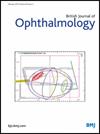视力中心对实现普遍眼保健覆盖的影响:印度南部眼保健服务的流行、覆盖和利用情况
IF 3.5
2区 医学
Q1 OPHTHALMOLOGY
引用次数: 0
摘要
视力中心(VC)模式的发展是为了满足农村和贫困社区的初级眼保健需求,克服劳动力和资源方面的挑战。尽管运行了二十多年,但其影响并没有得到充分的证明。我们通过比较印度Theni地区VCs半径5公里以内和以外的居民的视力障碍(VI)患病率、眼科保健利用率和服务覆盖率来评估其有效性。方法2016年至2018年在泰米尔纳德邦Theni地区进行了一项基于人群的横断面研究。采用整群随机抽样,对7127名年龄≥40岁的受试者进行了调查。我们将他们分为第1组(住在距离VC 5公里以内)和第2组(住在5公里以外)。我们比较了两组之间的VI患病率、使用率、白内障手术覆盖率(CSC)、有效白内障手术覆盖率(eCSC)、屈光不正覆盖率(REC)和有效屈光不正覆盖率(eREC)。结果与组2 (n=3999)相比,组1 (n=3128)年龄-性别调整后的VI患病率较低(18.1% vs 25.2%),眼保健使用率较高(66.7% vs 52.3%)。此外,1组的CSC (63.9% vs 55.0%)和eCSC (44.8% vs 32.6%)均优于2组。1组和2组远视力REC分别为49.7%和26.6%,eREC分别为47.9%和24.5%。第1组近视力覆盖率为22.1%,第2组为12.5%。结论风险投资极大地促进了农村和服务不足地区的眼科保健工作。与远离风险投资中心的居民相比,风险投资中心附近的居民VI患病率较低,使用率较高,覆盖率更好,表明该模式在提高眼科护理的可及性和可负担性方面的有效性。如有合理要求,可提供资料。所有与研究相关的数据都包含在文章中或作为补充信息上传。本文章由计算机程序翻译,如有差异,请以英文原文为准。
Impact of Vision Centres on achieving universal eye health coverage: prevalence, coverage and utilisation of eye care services in Southern India
Background The Vision Centre (VC) model evolved to meet primary eye care needs in rural and underprivileged communities, overcoming workforce and resource challenges. Despite over two decades of operation, its impact is not well-documented. We evaluated its effectiveness by comparing prevalence of visual impairment (VI), eyecare utilisation and service coverage among residents within and beyond a 5 km radius of VCs in Theni district, India. Methods We conducted a population-based cross-sectional study in Theni district, Tamil Nadu, from 2016 to 2018. Using cluster random sampling, we examined 7127 subjects aged ≥40 years. We categorised them into Group 1 (living within 5 km of VC) and Group 2 (living beyond 5 km). We compared the prevalence of VI, utilisation, cataract surgical coverage (CSC), effective cataract surgical coverage (eCSC), refractive error coverage (REC) and effective refractive error coverage (eREC) between the groups. Results Group 1 (n=3128) had lower age-sex-adjusted prevalence of VI (18.1% vs 25.2%) and higher eye care utilisation (66.7% vs 52.3%) compared with Group 2 (n=3999). Additionally, Group 1 demonstrated better CSC (63.9% vs 55.0%) and eCSC (44.8% vs 32.6%) than Group 2. REC for distance vision was 49.7% in Group 1 and 26.6% in Group 2, while eREC was 47.9% and 24.5%, respectively. Near vision coverage was 22.1% in Group 1 and 12.5% in Group 2. Conclusion VCs greatly enhance eye care in rural and underserved areas. Residents near VCs had lower prevalence of VI, higher utilisation and better coverage compared with those farther away, demonstrating the model’s effectiveness in improving eye care access and affordability. Data are available upon reasonable request. All data relevant to the study are included in the article or uploaded as supplementary information.
求助全文
通过发布文献求助,成功后即可免费获取论文全文。
去求助
来源期刊
CiteScore
10.30
自引率
2.40%
发文量
213
审稿时长
3-6 weeks
期刊介绍:
The British Journal of Ophthalmology (BJO) is an international peer-reviewed journal for ophthalmologists and visual science specialists. BJO publishes clinical investigations, clinical observations, and clinically relevant laboratory investigations related to ophthalmology. It also provides major reviews and also publishes manuscripts covering regional issues in a global context.

 求助内容:
求助内容: 应助结果提醒方式:
应助结果提醒方式:


